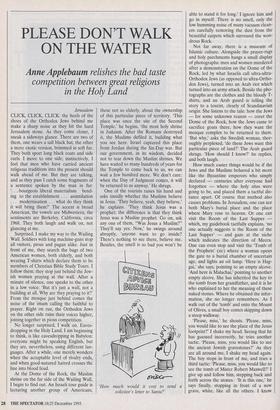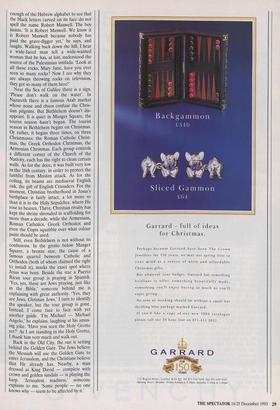PLEASE DON'T WALK ON THE WATER
Anne Applebaum relishes the bad taste
competition between great religions in the Holy Land
Jerusalem CLICK, CLICK, CLICK: the heels of the shoes of the Orthodox Jews behind me make a sharp noise as they hit the hard Jerusalem stone. As they come closer, I sneak a sideways glance. There are two of them, one wears a tall black hat, the other a more exotic version, brimmed in soft fur. They both sport long black coats and side curls. I move to one side; instinctively, I feel that men who have carried ancient religious traditions into the present should walk ahead of me. But they are talking, and as they pass I catch some fragments of a sentence spoken by the man in fur: `.. . bourgeois liberal materialism bend- ing to the establishment . . . assimilation . .. modernisation .. . what do they think it will bring them?' The accent is broad American, the vowels are Midwestern, the sentiments are Berkeley, California, circa 1968. They both laugh and walk on, not glancing at me.
Surprised, I make my way to the Wailing Wall. Soldiers with long machine-guns stop all visitors, pious and pagan alike. Just in front of me, they search the bags of two American women, both elderly, and both wearing T-shirts which declare them to be members of Christian Bible Study Tours. I follow them; they stop just behind the Jew- ish women praying at the wall. After a minute of silence, one speaks to the other in a low voice: But it's just a wall, not a building at all. Why are they praying to it?' From the mosque just behind comes the noise of the imam calling the faithful to prayer. Right on cue, the Orthodox Jews on the other side raise their voices higher, joining together in pious competition.
No longer surprised, I walk on Eaves- dropping in the Holy Land, I am beginning to think, is like eavesdropping in Babylon: everyone might be speaking English, but they are, nevertheless, using different lan- guages. After a while, one merely wonders when the acceptable level of rivalry ends, and when good-natured hatred crosses the line into blood feud.
At the Dome of the Rock, the Muslim shrine on the far side of the Wailing Wall, I begin to find out. An Israeli tour guide is lecturing another group of Americans, these not so elderly, about the ownership of this particular piece of territory. 'This place was once the site of the Second Temple,' he begins, 'the most holy shrine in Judaism. After the Romans destroyed it, the Muslims defiled it, building what you see here. Israel captured this place from Jordan during the Six-Day war. But our government, in its wisdom, decided not to tear down the Muslim shrines. We have waited so many hundreds of years for the Temple to come back to us, we can wait a few hundred more. We don't care: when the Day of Judgment comes, it will be returned to us anyway.' He shrugs.
One of the tourists raises his hand and asks timidly whether the Muslims believe in Jesus. 'They believe, yeah, they believe,' he explains. 'They think Jesus was a prophet; the difference is that they think Jesus was a Muslim prophet. Go on, ask any one of them, "Was Jesus a Muslim?" They'll say yes. Now,' he swings around abruptly, 'anyone want to go inside? There's nothing to see there, believe me. Besides, the smell is so bad you won't be `How much would it cost to send a solicitor's letter to Santa?' able to stand it for long.' I ignore him and go in myself. There is no smell, only the low humming noise of many vacuum clean- ers carefully removing the dust from the beautiful carpets which surround the won- drous Rock.
Not far away, there is a museum of Islamic culture. Alongside the prayer-rugs and holy parchments hangs a small display of photographs: men and women murdered after a demonstration on the Dome of the Rock, led by what Israelis call ultra-ultra- Orthodox Jews (as opposed to ultra-Ortho- dox Jews), turned into an Arab riot which turned into an army attack. Beside the pho- tographs are the clothes and the bloody T- shirts, and an Arab guard is telling the story to a tourist, clearly of Scandinavian origin. She listens to the tale: how the Jews — for some unknown reason — covet the Dome of the Rock, how the Jews came to sacrifice goats there, how they want the mosque complex to be returned to them. `But why,' asks the Swedish woman, thor- oughly perplexed, 'do these Jews want this particular piece of land?' The Arab guard shrugs. 'How should I know?' he replies, and both laugh.
How much easier things would be if the Jews and the Muslims behaved a bit more like the Byzantine emperors who simply declared — centuries after everyone had forgotten — where the holy sites were going to be, and placed them a tactful dis- tance apart. Of course that method also causes problems. In Jerusalem, one can see both Mary's burial place and the place where Mary rose to heaven. Or one can visit the Room of the Last Supper — which, my guidebook tactfully explains, 'no one actually suggests is the Room of the Last Supper' — and gaze at the niche which indicates the direction of Mecca. One can even stop and visit the 'Tomb of the Prophets' (sic) where a woman opens the gate to a burial chamber of uncertain age, and lights an oil lamp. 'Here is Hag- gai,' she says, pointing to an empty alcove. `And here is Malachai,' pointing to another empty alcove. She has inherited the key to the tomb from her grandfather, and it is he who explained to her the meaning of these naked stones. Where he obtained the infor- mation, she no longer remembers. As I walk out of the 'tomb' and onto the Mount of Olives, a small boy comes skipping down a steep walkway.
`Please, miss,' he shouts. 'Please, miss, you would like to see the place of the Jesus footprint?' I shake my head. Seeing that he has guessed incorrectly, he tries another tactic. 'Please, miss, you would like to see the ancient Jewish gravestones?' As they are all around me, I shake my head again. The boy stops in front of me, and tries a third tactic: 'Please, miss, you would like to see the tomb of Mister Robert Maxwell?' give up and follow him, stepping back and forth across the stones. 'It is this one,' he says finally, stopping in front of a new grave, white, like all the others. I know
enough of the Hebrew alphabet to see that the black letters carved on its face do not spell the name Robert Maxwell. The boy insists. 'It is Robert Maxwell. We know it is Robert Maxwell because nobody has paid the grave-digger yet,' he says, and laughs. Walking back down the hill, I hear a wide-faced man tell a wide-waisted woman that he has, at last, understood the source of the Palestinian intifada. 'Look at all these rocks, Mary Jane, have you ever seen so many rocks? Now I see why they are always throwing rocks on television, they got so many of them here!'
Near the Sea of Galilee there is a sign, `Please don't walk on the water'. In Nazareth there is a famous Arab market whose noise and chaos confuse the Chris- tian pilgrims. But Bethlehem doesn't dis- appoint. It is quiet in Manger Square, the tourist season hasn't begun. The tourist season in Bethlehem begins on Christmas. Or rather, it begins three times, on three Christmases: the Roman Catholic Christ- mas, the Greek Orthodox Christmas, the Armenian Christmas- Each group controls a different corner of the Church of the Nativity, each has the right to clean certain walls. As for the door, it was built very low in the 16th century, in order to protect the faithful from Muslim attack. As for the ceiling, its beams are mediaeval English oak, the gift of English Crusaders. For the moment, Christian brotherhood in Jesus's birthplace is fairly intact, a lot more so than it is in the Holy Sepulchre, where He rose to heaven. There, Christian rivalry has kept the shrine shrouded in scaffolding for more than a decade, while the Armenians, Roman Catholics, Greek Orthodox and even the Copts squabble over what colour paint should be used.
Still, even Bethlehem is not without its confusions. In the grotto below Manger Square, a bronze star, the cause of a famous quarrel between Catholic and Orthodox (both of whom claimed the right to install it), marks the exact spot where Jesus was born. Beside the star a Puerto Rican tour group is praying in Spanish. `Yes, yes, these are Jews praying, just like in the Bible,' someone behind me is explaining with great authority. 'Yes, they are Jews, Christian Jews.' I turn to identify the speaker, but the tour group is gone. Instead, I come face to face with yet another guide. 'I'm Michael — Michael Angelo,' he explains, laughing at his amus- ing joke. 'Have you seen the Holy Grotto yet?' As I am standing in the Holy Grotto, I thank him very much and walk out.
Back in the Old City, the sun is setting behind the Golden Gate. The Jews believe the Messiah will use the Golden Gate to enter Jerusalem, and the Christians believe that He already has. Nearby, a man dressed as King David — complete with crown and golden sandals — is playing the harp. 'Jerusalem madness,' someone explains to me. 'Some people — no one knows why — seem to be affected by it.'











































































































 Previous page
Previous page